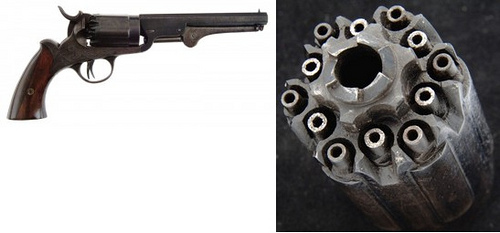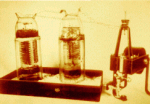6-Chamber Revolver Can Fire 12 Rounds

This unique revolver invented by John Walch in 1859. It has two triggers and two hammers to fire two rounds that were loaded into each chamber. James R. Rummel explains how it works:
The secret to the extra firepower is what is known as “superimposed loads”. Basically, the chambers are loaded with a powder charge with a bullet sitting on top, as is normal. Then another powder charge and bullet is loaded on top of the first.
The reason this doesn’t lead to an exploded gun and missing fingers is due to the unique ignition system. There are two percussion caps for every cylinder.
The gun is equipped with two hammers, and two triggers. Both hammers are cocked at the same time, but only the right-handed trigger is squeezed to set off the first shot. Then the left-hand trigger is squeezed, the left-hand hammer drops, and the second bullet goes flying. Cocking the hammers again will cause the cylinder to revolve as per normal.
Percussion caps are supposed to create a spark to set off the powder. Notice the ring of nipples to the outside of the cylinder? Those are the caps that are set off by the right-hand hammer, the hammer you are supposed to squeeze first. They don’t have a hole which goes directly into the back of the chamber, but instead channels the spark down a little tunnel. After about an inch, the tunnel makes a left hand turn and finally emerges into the chamber.
The hope is that the extra inch traveled will mean that the spark from the right-hand trigger will set off the powder charge in front, which will send the first bullet flying down the barrel while leaving the second bullet and powder charge untouched. The left-hand trigger will cause the left-hand hammer to drop, which will impact on the inner percussion cap, and hopefully cause the second charge to ignite.
The Battery That's Been Operating Continuously for the Past 60 Years
 It keeps going…and going…and going. Karpen’s Pile, a battery built in Romania, has been providing power since the 1950s:
It keeps going…and going…and going. Karpen’s Pile, a battery built in Romania, has been providing power since the 1950s:The prototype has been assembled in 1950 and consists of two series-connected electric piles moving a small galvanometric motor. The motor moves a blade that is connected to a switch. With every half rotation, the blade opens the circuit and closes it at the the start of the second half. The blade’s rotation time had been calculated so that the piles have time to recharge and that they can rebuild their polarity during the time that the circuit is open.The science behind it (assuming that it’s not an elaborate hoax) challenges conventional physics:
The purpose of the motor and the blades was to show that the piles actually generate electricity, but they’re not needed anymore, since current technology allows us to measure all the parameters and outline all of them in a more proper way.
According to some who studied Karpen’s theoretical work, the pile he invented defies the second principle of thermodynamics (referring to the transformation of thermal energy into mechanical work), and this makes it a second-degree perpetual motion machine. Others say it doesn’t, being merely a generalization to the law, and an application of zero point energy.*****
If Karpen was right, and the principle is 100% correct, it would revolutionize all of the physics theories from the bottom up, with hard to imagine consequences. Though I guess this isn’t going to happen very soon, the museum still needs proper private funding to acquire the necessary security equipment required by the police to exhibit the device.

No comments:
Post a Comment